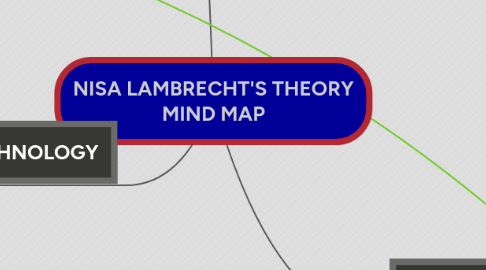
1. TECHNOLOGICAL THEORIES
1.1. MEDIA ECOLOGY:
1.1.1. KEY THEORISTS:
1.1.1.1. Postman & McLuhan
1.1.2. MOTTO:
1.1.2.1. 'The Medium is the Message'
1.1.3. KEY IDEA
1.1.3.1. Currently in the Digital Era, Technology influences Society
1.1.4. IMPLICATION ON EDUCATION
1.1.4.1. Correct in the sense that 'technology influences society', but seems to be lacking in the sense that it has to concern itself more in an educational sense, instead of a primarily technological one.
1.2. SCOT:
1.2.1. SOCIAL CONSTRUCTION OF TECHNOLOGY
1.2.1.1. KEY THEORISTS:
1.2.1.1.1. Bijker & Pinch
1.2.1.2. MOTTO & KEY IDEA:
1.2.1.2.1. Society and human action influence technology
1.2.1.3. IMPLICATION ON EDUCATION
1.2.1.3.1. Unlike Media Ecology, this focuses on how society focuses on and makes use of technology, other than the other way around. SCOT leaves a broader range of educational prospects.
2. TPACK & TEACHNOLOGY
2.1. TPACK:
2.1.1. SECTIONS
2.1.1.1. Pedagogical Knowledge
2.1.1.1.1. PCK
2.1.1.2. Content Knowledge
2.1.1.3. Technological Knowledge
2.1.1.3.1. TPK
2.1.1.3.2. TCK
2.1.2. Blends the needs of Content, Pedagogical and Technological knowledge together to create a more substantial base for teachers to rely on in this digital age
2.1.3. Developed when Punya Mishra and Matthew Koehler added the Technological factor to Lee Shulman's PCK theory
2.1.4. Link to diagram of both TPACK
2.1.4.1. Includes an outer-layer which is the 'context' surrounding: the idea that "teachers can only do what they have the power to do"
2.2. PHILOSOPHY OF TEACHNOLOGY
2.2.1. A theory of integrating what a teacher believes (pedagogically) and how they believe technology should be integrated into the subject being taught
2.2.2. In conjunction with TPACK's philosophy and theory
2.2.3. Alberta's 'Teacher's Professional Work Plan'
2.2.3.1. An outline of one's professional goals and activities one expects to have done by the next year
2.2.3.2. Required
3. LEARNING THEORIES
3.1. BEHAVIORISM
3.1.1. MOTTO:
3.1.1.1. 'Practice Makes Perfect'
3.1.2. KEY THEORISTS:
3.1.2.1. Pavlov, Watson, Thorndike, Skinner
3.1.3. KEY IDEAS
3.1.3.1. Stimulus response, Conditioning, Modelling, Shaping, Drilling and Practicing
3.1.4. PRIMARY MODE OF INSTRUCTION:
3.1.4.1. Teacher-directed lectures
3.1.5. PRACTICES:
3.1.5.1. Curriculum, Direct Instruction, Behavior Analysis, Classroom Management, Rewards System
3.1.6. CRITICISMS:
3.1.6.1. Oversimplification, assumes the mind is a 'Blank Slate', ignores the fact that people can adapt
3.1.7. IMPLICATION ON EDUCATION:
3.1.7.1. This is the theory that has been used the most all over the world, and was seen as most manageable in classes that were dealing with classes of 30+ children at a time. Behaviorism is the traditional theory that has been dictating how to teach the future generations.
3.2. COGNITIVISM
3.2.1. MOTTO:
3.2.1.1. 'The Mind is a Computer'
3.2.2. KEY THEORISTS:
3.2.2.1. Piaget, Gagne, Vygotsky, Bruner
3.2.3. KEY IDEAS
3.2.3.1. Atkinson-Shiffrin Memory Model
3.2.3.1.1. Sensory Memory
3.2.3.1.2. Short-Term Memory
3.2.3.1.3. Long-Term Memory
3.2.3.2. Meaningful Effect, Serialization, Motivation
3.2.4. PRACTICES:
3.2.4.1. Schemas
3.2.4.2. Retention, Mnemonic Devices, Organization, Metaphor Symbolism, Mind Maps
3.2.5. CRITICISMS:
3.2.5.1. Too focused on knowledge and disregards the affective nature of human beings
3.2.6. IMPLICATION ON EDUCATION
3.2.6.1. Cognitivism is a step towards developing a theory, and eventually a practice, that can successfully mold the traditional sense of teaching and the rising usage of technology. Cognitivism focuses to much on the technological and less on the aspects of a person
3.2.7. COGNITIVE LOAD THEORY:
3.2.7.1. IDEA:
3.2.7.1.1. That processing information can over- or under-load the Working Memory (previously Short-Term Memory)
3.2.7.2. PARTS:
3.2.7.2.1. EXTRANEOUS:
3.2.7.2.2. INTRINSIC:
3.2.7.2.3. GERMANE:
3.3. CONSTRUCTIVISM:
3.3.1. MOTTO:
3.3.1.1. 'The Mind is a Rhizome (network)'
3.3.2. KEY IDEAS:
3.3.2.1. Teacher as facilitator, problem & project based learning, discovery, interactive, Vygotsky’s Zone of proximal development
3.3.3. PRACTICES:
3.3.3.1. Complex. Letting students learn through active and interactive features
3.3.3.1.1. eg: Lego robotics and learning physics
3.3.4. CRITICISMS:
3.3.4.1. Difficult to assess, needs mature learners, time consuming, still in need of research/evidence
3.3.5. IMPLICATIONS ON EDUCATION:
3.3.5.1. Constructivism helps students who are already learned in a subject enhance their understanding through active learning. This highly complex theory involves a lot of deeper theories and understanding
3.4. CONNECTIVISM:
3.4.1. FOUNDERS:
3.4.1.1. George Siemens and Stephen Downes
3.4.2. KEY IDEAS:
3.4.2.1. Learning comes from acquiring and learning the different perspectives of a diversity of sources
3.4.2.2. Ability to see connections between fields and ideas
3.4.3. CRITICISMS:
3.4.3.1. Is the formality of this theory legitimate?
3.4.4. IMPLICATIONS ON EDUCATION
3.4.4.1. This is one that's closest of meshing traditional and technological theories together: it allows children to explore different concepts and lets them consider their choices to create their own theory and way of thinking.
